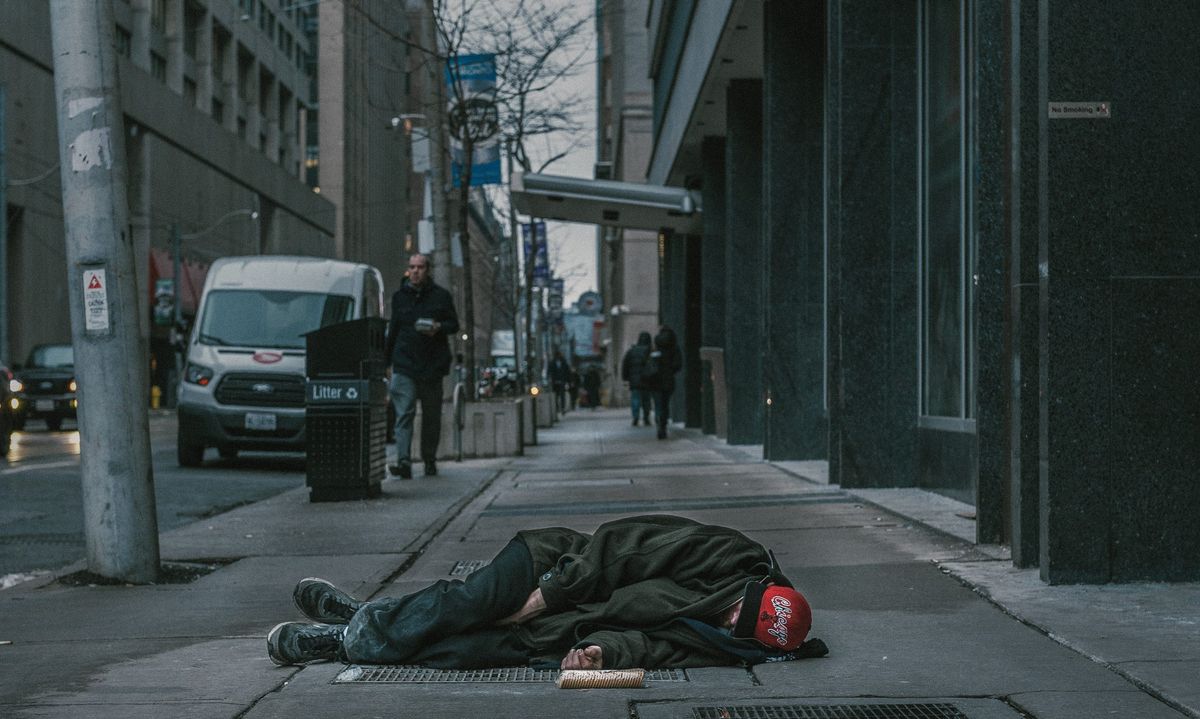America’s homeless continue to suffer during COVID-19

A few minutes every morning is all you need.
Stay up to date on the world's Headlines and Human Stories. It's fun, it's factual, it's fluff-free.
According to a United States government report in 2019, over 500,000 people on any given night suffer from homelessness in America.
65% of these individuals seek refuge in homeless shelters, while the other 35%, representing some 200,000 people, live on the streets or seek shelter in parks, abandoned buildings or cars.
As for the distribution of homelessness within the country, while the phenomenon exists in every state to a certain extent, some locations have far higher numbers of homeless individuals.
In 2019, California and New York had by far the highest number of homeless, representing about 26% and 16% of the total number of homeless individuals in America.
California is the most populous state in the country with over 39 million people and New York is the fourth-most populous state. Texas, the state with the second-highest number of people, over 28 million, recorded just 4.5% of the total homeless population in America.
While the homeless undoubtedly suffer during the best of times, with estimates indicating that about a quarter to a third of homeless individuals grapple with some form of mental illness, the COVID-19 pandemic has put into sharp relief the collective pain of a severely marginalized group of people.
Not only do homeless individuals find it difficult to take the necessary precautions to reduce disease transmission, like basic hygiene precautions and social distancing, if they do get sick they often have little opportunity to secure professional medical care.
Although comprehensive numbers on homeless individuals contracting and spreading the coronavirus is difficult to calculate given their existence on the margins of society, there is evidence to suggest that the homeless have an outsized risk of contracting the disease.
According to researchers from the University of Southern California, only 1% of respondents within the homeless community at a notorious downtown Los Angeles encampment known as Skid Row reported that they didn’t know about COVID-19 in March 2020 and 65% considered it a very serious threat. However, a lack of basic hygiene items and personal bathrooms complicated efforts to combat the virus.
The authors noted that in one of the worst possible scenarios of coronavirus transmission in the US, with an infection rate of 40% of the population, an estimated 21,000 homeless individuals might require hospitalization.
As of June 13, the US Centers for Disease Control and Prevention (CDC) claimed that the overall percentage of COVID-19 tests coming back positive in the US was 6.4%.
Homeless perspectives
In San Francisco, a US city where the rising cost of living has contributed to significant increases in the number of homeless over the past decade, some city residents who live on the streets are fearing for their lives.
“They [public officials] need to open up a church and quarantine or do something,” said Louis Charles Brown, a homeless man in San Francisco. “Right now I’m taking a chance on my life by being out here,” he added.
In response to the virus, San Francisco officially sanctioned homeless encampments in late May in an attempt to help homeless people get through the worst of the outbreak. About 80 tents were set up near City Hall, where meals and showers were reportedly made available.
However, in a city with over 8,000 homeless people, many others are forced to stay outside of the sanctioned area. Although the city has made it a policy to keep tents standing regardless of the location, many are still struggling.
According to one woman taking up residence in the encampment, despite attempts by the local government to take care of the homeless population, she did not receive a warm welcome.
“I don’t live here, that’s what they told me,” said Jasmine Villereal, who reportedly was forced to bathe in public fountains and bathroom sinks after the usual locations she sought out were closed amid virus-related shutdowns.
Is the government doing enough?
San Fransisco isn’t the only city to offer policy solutions to the homeless population during COVID-19. Los Angeles, New York and Chicago are also offering various support services. But still, many argue that the government isn’t doing enough.
According to Nan Roman, the president and CEO of the National Alliance to End Homelessness, government-sanctioned encampments could lead to a disincentive over the long term to provide lasting housing solutions to the homeless community.
“It’s almost like we’re giving ourselves permission that it’s OK that people will sleep outside, and once we’ve given ourselves that permission, it’s very difficult to get the initiative together to do otherwise," Roman argued.
According to reports, late last year the Trump administration suggested forcibly removing homeless individuals from the streets of California and relocating them under government care to unused federal buildings. The administration later backed down from that plan and committed to working with local officials.
In September 2019, the Trump administration rejected requests from California to increase federal funding for the homeless crisis in the state, alleging that local policies were exacerbating the problem, therefore making increased funding a bad policy move.
Unsubstantiated claims
As for the coronavirus, the country’s homeless population has also been victims of misinformation.
In mid May, amid anti-lockdown protests across the country, viral Internet posts alleged that the virus was not severely impacting the homeless, which supposedly was evidence that the government’s social distancing and economic shutdown protocols were unreasonable.
“If the coronavirus is so deadly why hasn’t it wiped out the homeless,” one post read.
According to FactCheck.org, a nonprofit that aims to reduce deception in the US public sphere, data from the CDC and other sources shows that the virus has indeed impacted homeless communities around the country.
In one CDC report on homeless shelters in Boston, Seattle, San Francisco and Atlanta, about 25% of the homeless population across 19 shelters had tested positive from March 27 to April 15.
In early May, US scientists also warned that homeless individuals were likely spreading the virus under the radar and that testing for these individuals should be considerably ramped up.
Is homelessness rising?
While homelessness has been on a slow decline over the previous decade in the US, in 2017 homelessness started rising, although data before the pandemic suggests that it was still below what it was a decade ago.
With widespread job losses and an uncertain economic future for many Americans in the wake of COVID-19, some fear that homelessness will be on the rise for the foreseeable future.
According to data from the Los Angeles Homeless Services Authority released in mid June, the homeless population in Los Angeles County jumped 12.7% in 2019 compared to the previous year.
Heidi Marston, the director of the Homeless Services Authority in Los Angeles, said that the threat of homelessness is real for many individuals.
“These are folks who are one missed paycheck, one family tragedy, healthcare crisis, car accident — whatever it is — away from losing their housing.”
Have a tip or story? Get in touch with our reporters at tips@themilsource.com




Comments ()